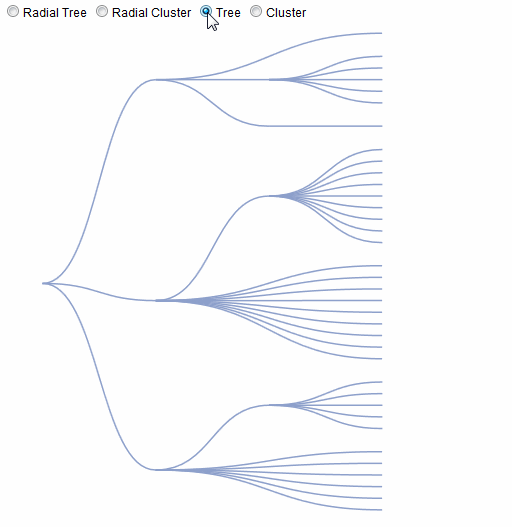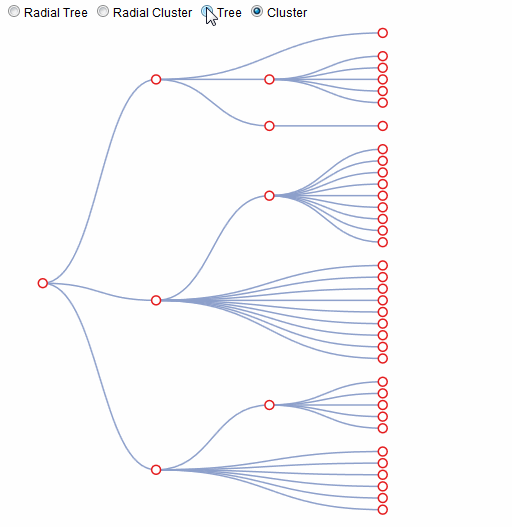I don't see why it would be that hard so long as all your layouts have the same overall structure of link-paths, circle nodes and text labels.
Just make sure all your objects, including your link paths, have a good data-key that is independent of the data attributes created by the layout functions. Then for each transition, update the data with the results of the appropriate layout function and draw that layout.
I've got the transition to radial tree implemented here: http://jsfiddle.net/YV2XX/5/
Key code:
//Radial Tree layout//
var diameter = 500;
var radialTree = d3.layout.tree()
.size([360, diameter / 2 ])
.separation(function(a, b) { return (a.parent == b.parent ? 1 : 2) / a.depth; });
var radialDiagonal = d3.svg.diagonal.radial()
.projection(function(d) { return [d.y, d.x / 180 * Math.PI]; });
function transitionToRadialTree() {
var nodes = radialTree.nodes(root), //recalculate layout
links = radialTree.links(nodes);
svg.transition().duration(1500)
.attr("transform", "translate(" + (diameter/2)
+ "," + (diameter/2) + ")");
//set appropriate translation (origin in middle of svg)
link.data(links, function(d){
return d.source.name + d.target.name;})
.transition().duration(1500)
.attr("d", radialDiagonal); //get the new radial path
node.data(nodes, function(d){
return d.name ;})
.transition().duration(1500)
.attr("transform", function(d) { return "rotate(" + (d.x - 90) + ")translate(" + d.y + ")"; })
node.select("circle")
.transition().duration(1500)
.attr("r", 4.5);
node.select("text")
.transition().duration(1500)
.attr("dy", ".31em")
.attr("text-anchor", function(d) { return d.x < 180 ? "start" : "end"; })
.attr("transform", function(d) { return d.x < 180 ? "translate(8)" : "rotate(180)translate(-8)"; });
};
The layout code is all from http://bl.ocks.org/mbostock/4063550, I've just changed it to be an update instead of an initialization.
Also note that I have moved the variable declaration for root outside of the data-reading method, so it can be re-accessed by the transition functions.
Layout still needs some finessing, but you get the idea.
Now, if you wanted one of the transitions to be a partition, treemap or other layout that doesn't use the node-link structure, they it gets more complicated...

